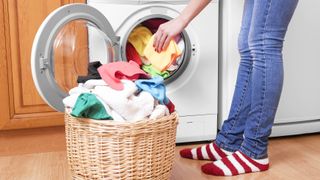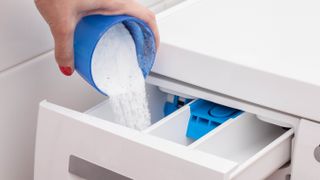Review sản phẩm
7 sai lầm cần tránh khi giặt chăn ga
Giới thiệu 7 mistakes to avoid when washing bedding
7 sai lầm cần tránh khi giặt chăn ga
#Lựa chọn sản phẩm chất lượng tại Queen Mobile#
Hiện nay, thông qua Queen Mobile, chúng ta có thể dễ dàng đánh giá sản phẩm và mua ngay những điện thoại di động chất lượng từ các thương hiệu nổi tiếng. Tuy nhiên, để đảm bảo chất lượng sản phẩm cũng như tránh những sai lầm khi sử dụng điện thoại, hãy cùng tìm hiểu 7 sai lầm phổ biến khi giặt chăn ga để tránh những rủi ro không đáng có.
1. Không lựa chọn chất liệu phù hợp: Đầu tiên, hãy chắc chắn lựa chọn chăn ga có chất liệu phù hợp với nhu cầu sử dụng của bạn. Ví dụ, nếu bạn có da nhạy cảm, hãy tránh sử dụng chăn ga từ vải bông tự nhiên, nhưng hãy chọn chăn ga từ vải nhung mềm mại hơn.
2. Giặt không đúng cách: Quá trình giặt chăn ga đòi hỏi sự chăm sóc kỹ lưỡng để đảm bảo không gây hư hỏng chất liệu và màu sắc. Hãy đọc kỹ hướng dẫn giặt trên nhãn sản phẩm và tuân theo hướng dẫn để đạt hiệu quả tốt nhất.
3. Sử dụng nhiều chất tẩy mạnh: Một sai lầm thường gặp là sử dụng quá nhiều chất tẩy mạnh khi giặt chăn ga. Điều này không chỉ gây tổn thương cho chất liệu mà còn có thể làm hỏng máy giặt của bạn. Hãy sử dụng một lượng chất tẩy nhưng không quá nhiều để đảm bảo vệ sinh sạch sẽ mà không gây hại.
4. Phơi không đúng cách: Khi phơi chăn ga, hãy tránh ánh nắng mặt trời trực tiếp để tránh mất màu và làm giảm tuổi thọ của sản phẩm. Ngoài ra, hãy đảm bảo chăn ga đã khô hoàn toàn trước khi sử dụng để tránh vi khuẩn phát triển.
5. Không làm sạch thường xuyên: Việc không giặt chăn ga thường xuyên là một sai lầm lớn. Chăn ga ứ đọng bụi, mồ hôi và vi khuẩn từ cơ thể người dùng, từ đó gây mất vệ sinh và mùi hôi. Vì vậy, hãy bảo đảm giặt chăn ga ít nhất một tuần một lần để đảm bảo vệ sinh và sức khỏe.
6. Không kiểm tra kỹ trước khi sử dụng: Trước khi sử dụng chăn ga mới, hãy kiểm tra kỹ xem có bất kỳ lỗi hay hư hỏng nào. Điều này giúp tránh những bất tiện không đáng có sau khi đã mua sản phẩm.
7. Lựa chọn không đúng cửa hàng: Cuối cùng, đừng quên lựa chọn cửa hàng uy tín và đáng tin cậy như Queen Mobile để đảm bảo chất lượng sản phẩm. Chỉ từ các cửa hàng đáng tin cậy, bạn mới có thể nhận được những sản phẩm chất lượng, đảm bảo và được đánh giá tốt.
Với những lưu ý trên, hãy đặt niềm tin vào sản phẩm từ Queen Mobile và tránh những sai lầm không đáng có khi giặt chăn ga của bạn. Vì sức khỏe và sự thoải mái của bạn, đừng để bỏ qua các yếu tố quan trọng trong quá trình sử dụng và chăm sóc sản phẩm. #QueenMobile #SảnPhẩmChấtLượng #SứcKhỏeVàThẩmMỹ
Mua ngay sản phẩm tại Việt Nam:
QUEEN MOBILE chuyên cung cấp điện thoại Iphone, máy tính bảng Ipad, đồng hồ Smartwatch và các phụ kiện APPLE và các giải pháp điện tử và nhà thông minh. Queen Mobile rất hân hạnh được phục vụ quý khách….
_____________________________________________________
Mua #Điện_thoại #iphone #ipad #macbook #samsung #xiaomi #poco #oppo #snapdragon giá tốt, hãy ghé [𝑸𝑼𝑬𝑬𝑵 𝑴𝑶𝑩𝑰𝑳𝑬]
✿ 149 Hòa Bình, phường Hiệp Tân, quận Tân Phú, TP HCM
✿ 402B, Hai Bà Trưng, P Tân Định, Q 1, HCM
✿ 287 đường 3/2 P 10, Q 10, HCM
Hotline (miễn phí) 19003190
Thu cũ đổi mới
Rẻ hơn hoàn tiền
Góp 0%
Thời gian làm việc: 9h – 21h.
KẾT LUẬN
Trong bài viết này, chúng tôi chia sẻ với bạn bảy sai lầm phổ biến khi giặt chăn ga. Đầu tiên, nhiều người quên dùng nhiệt độ phù hợp cho loại vải. Bài viết cũng nhấn mạnh việc không giặt chăn ga quá chật trong máy giặt, vì điều này có thể gây hỏng chăn ga và làm giảm hiệu suất giặt. Ngoài ra, không nên dùng quá nhiều chất tẩy rửa hoặc chất làm mềm trong quá trình giặt vì điều này có thể gây kích ứng da. Chúng tôi cũng khuyến nghị không giặt quá nhiều chăn ga cùng một lúc, vì điều này có thể làm giảm sự sạch sẽ và hiệu quả của quá trình giặt. Cuối cùng, hãy tránh việc phơi chăn ga trực tiếp dưới ánh nắng mặt trời, vì điều này có thể làm mất màu sắc và làm giảm tuổi thọ của chăn ga.
Come laundry day, routine often takes over. We load our hampers full of dirty clothes into the best washing machines, set the appropriate cycle, and circle back to dry the results. But, no matter how familiar you are with this process, there are still mistakes that people often make — particularly when it comes to bedding.
Such mistakes can deter the wash performance, wreck your sheets or could even be one of the 7 mistakes damaging your washing machine. In any case, these are something you’ll want to steer clear of, particularly when you consider how expensive bedding can be. To help you out, we’ve listed 7 of the most common mistakes here, along with the consequences and what to do instead. So your sheets will ultimately last longer, and your washing machine will last longer too.
1. Not washing your bedding often enough

The first big mistake is not washing your bedding often enough. While this won’t degrade your bedding or your washing machine, it’s not particularly hygienic. Every night we spend in our bed, we secrete sweat and drool, and spread stains from residual make up and moisturizer. We attract no end of dust mites and create an ideal breeding ground for bacteria on top of this, so keeping your bedding clean and fresh is essential. (Here’s how often you should wash your sheets, according to experts).
That’s why you should take the time to wash your bedding once a week — potentially more often if there’s sickness in your household. Don’t forget about washing your pillows and the comforter themselves once in a while too. If you notice yellow stains on these, that’s from residual sweat, and these can contain no end of bacteria as a consequence. In general, you should wash your pillows and comforter every four months. To keep your bedding fresh once you wake, fold back the sheet every morning and air the mattress with the window open for a couple of hours. This will help any residual moisture escape.
For full guidance, here’s how to wash a pillow and how to wash a comforter.
2. Not doing up the buttons

There’s nothing more annoying than discovering a hidden sock in your sheets. Items will naturally collect in an open sheet during a wash cycle. Should you hang your washing to dry while it still contains a rogue item, it often results in musty laundry which needs to go through another wash cycle.
But, there’s an easy fix for this. Simply do up the fastening on your comforter and pillow cases before loading them into your washing machine. That way, rogue items can’t find their way in. While this does mean you will have to undo them again to fit your sheets, it saves time in terms of digging through for rogue items as well as musty results if you miss one.
Bed sheets are awkward for creating tangles in a clothes dryer nonetheless. We recommend an item which can aid with detangling, such as Wad-Free for Bed Sheets ($19, Amazon). Here are 7 ways to prevent your clothes from tangling in the clothes dryer if you want more tips.
3. Washing individual pillows

When it’s time to wash the pillows, we often dedicate an entire drum to each item — it’s only natural considering their size — but this is a big mistake. As these soak up the water and detergent, they will naturally shrink down and their weight will be increased. Towards the end of the cycle, a front-loading washing machine won’t be able to pick up enough momentum to spin. It’s not surprising when you consider such a weight is being thrown across the otherwise empty drum, causing the machine itself to shake and make a ruckus. If it forced itself to spin, it could actually damage itself and your floors in the process.
You need to balance out the load so your washing machine can safely spin. For this reason, it’s better to wash two pillows at once, rather than individually. Do this, and your machine should be able to wash and spin your bedding effectively. Always check your bedding’s care label as well as your washer’s manual to make sure both are suitable for this washing method though. Some materials, such as memory foam, are spot clean only, while others may require dry cleaning. Duvets or comforters which are labeled as machine-washable may require dry cleaning as well depending on its size and your washer’s capacity.
If your washing machine is vibrating regardless, here’s how to fix a shaky washing machine.
4. Overloading the machine

It’s all too tempting to ram our weekly laundry load alongside our bedding. But, while a full capacity technically saves on water and energy consumption, this is not a good idea. First, an overloaded washing machine won’t clean the load as effectively. This is because the detergent won’t be evenly distributed, and the clothes won’t be able to agitate as easily. An overloaded machine will likely fail to spin as well — just as with individual pillows, it can become unbalanced when overly full with excess weight. You will have to remove some of the sopping wet items to give it a chance to spin.
Only fill your washing machine to full capacity, and no further — consult your manual for guidance on the maximum capacity. Wash similar materials together so you can use the best settings, and avoid washing abrasive items in the same load which could damage delicate bed sheets. For instance, open zippers can easily tear through fragile materials as well as damage the inside of your machine. Always close zippers in the washing machine, but leave buttons unbuttoned so there’s less stress on the thread.
Open zippers are one of the 15 things you should never put in a washing machine.
5. Using incorrect settings

Most of us use the same settings no matter what we wash. But, there’s a reason your washing machine offers such a range of programs. Each will adjust its power and length depending on the load, helping your laundry to last longer while receiving the most appropriate wash. For instance, quick wash is one of the most overused functions — mainly for its speed and convenience. But, considering the bacteria your bedding harbors, it’s likely not a thorough enough wash. Here’s when you should and shouldn’t use the quick wash setting on your washing machine.
Always consult the care label to check the recommended settings. Your washing machine might have a dedicated bedding setting to simplify things, after which you only need set the temperature. Failing that, a normal cycle works just as well. Remember a lower temperature setting will save on energy consumption, but won’t offer as strong a cleaning performance, so choose depending on the bedding’s condition. A thorough hot wash once every so often is always recommended, but a cool cycle may be all that’s needed for everyday use.
6. Overdoing the detergent

If there’s bedding in the load, we often overdo the detergent. It’s only natural when you think about the size of what’s being washed. However, you don’t want to make this mistake. Not only is it wasteful, it’s counterproductive too. This is because too much detergent will actually impair its performance. The excess will prevent your clothes from making contact so effectively in the wash — slippery with a residual coating. So the wash performance itself is deterred.
Plus, if your washing machine fails to fully remove all traces of the detergent, your clothes will feel uncomfortable and ‘scrunchy’ to wear, and might bring on an allergic reaction. The suds remaining in your machine will encourage mildew on top of this, making sure you learn how to clean a washing machine that much faster. Always follow the dosage instructions for your laundry detergent, not using too much or too little. Here are 7 laundry detergent mistakes to avoid at all costs.
7. Not drying your bedding properly

Finally, your bedding needs to be dried quickly and effectively. So, if you’re hanging it to dry, it needs to be flat and spread out to air. While it doesn’t add to aesthetics, hanging your bedding over doors can work well — just make sure there’s no residual dirt on top. Bedding should not be bunched up or envelop other items which are trying to dry, otherwise it will significantly slow the process. Wherever it’s drying, the space needs to be ventilated to release the moisture — one of the best dehumidifiers can help here. If the weather’s good enough, you can always hang it up outside.
If you’re drying your bedding in a clothes dryer, make sure it’s dried alongside similar materials. Bedding can dry much more quickly compared to thicker items which retain water, such as towels. So if you dry these together, a clothes dryer’s sensor will likely fail and end up over-drying the bedding.
Once the cycle has finished, always check for damp patches, even if the majority of your sheets feel dry. If it’s damp in places, you can hang up your bedding for the final touches. Don’t throw it back in the dryer at this stage because you could damage the sections that are fully dry.
Check out these 7 clothes dryer mistakes to avoid at all costs.
More from Tom’s Guide
Xem chi tiết và đăng kýXem chi tiết và đăng kýXem chi tiết và đăng ký
Khám phá thêm từ Phụ Kiện Đỉnh
Đăng ký để nhận các bài đăng mới nhất được gửi đến email của bạn.





